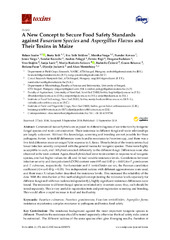Приказ основних података о документу
A New Concept to Secure Food Safety Standards against Fusarium Species and Aspergillus Flavus and Their Toxins in Maize
| dc.creator | Szabo, Balazs | |
| dc.creator | Toth, Beata | |
| dc.creator | Toldine, Eva Toth | |
| dc.creator | Varga, Monika | |
| dc.creator | Kovacs, Nandor | |
| dc.creator | Varga, Janos | |
| dc.creator | Kocsube, Sandor | |
| dc.creator | Palagyi, Andrea | |
| dc.creator | Bagi, Ferenc | |
| dc.creator | Budakov, Dragana | |
| dc.creator | Stojšin, Vera | |
| dc.creator | Lazić, Sanja | |
| dc.creator | Bodroža-Solarov, Marija | |
| dc.creator | Čolović, Radmilo | |
| dc.creator | Bekavac, Goran | |
| dc.creator | Purar, Božana | |
| dc.creator | Jocković, Đorđe | |
| dc.creator | Mesterhazy, Akos | |
| dc.date.accessioned | 2021-04-26T19:37:43Z | |
| dc.date.available | 2021-04-26T19:37:43Z | |
| dc.date.issued | 2018 | |
| dc.identifier.issn | 2072-6651 | |
| dc.identifier.uri | http://fiver.ifvcns.rs/handle/123456789/1752 | |
| dc.description.abstract | Commercial maize hybrids are exposed to different degrees of ear infection by toxigenic fungal species and toxin contamination. Their resistance to different fungi and toxin relationships are largely unknown. Without this knowledge, screening and breeding are not possible for these pathogens. Seven- to tenfold differences were found in resistance to Fusarium spp., and there was a five-fold difference in ear coverage (%) in response to A. flavus. Three hybrids of the twenty entries had lower infection severity compared with the general means for toxigenic species. Three were highly susceptible to each, and 14 hybrids reacted differently to the different fungi. Differences were also observed in the toxin content. Again, three hybrids had lower toxin content in response to all toxigenic species, one had higher values for all, and 16 had variable resistance levels. Correlations between infection severity and deoxynivalenol (DON) content were 0.95 and 0.82 (p = 0.001) for F. graminearum and F. culmorum, respectively. For fumonisin and F. verticillioides ear rot, the Pearson correlation coefficient (r) was 0.45 (p = 0.05). Two independent isolates with different aggressiveness were used, and their mean X values better described the resistance levels. This increased the reliability of the data. With the introduction of this methodological concept (testing the resistance levels separately for different fungi and with two isolates independently), highly significant resistance differences were found. The resistance to different fungal species correlated only in certain cases; thus, each should be tested separately. This is very useful in registration tests and post-registration screening and breeding. This would allow a rapid increase in food and feed safety. | en |
| dc.publisher | Basel : MDPI | |
| dc.relation | ToxFreeFeed Hungarian-Serbian IPA project - European Union, HUSRB/1002/122/062 | |
| dc.relation | Janos Bolyai Research Scholarship of the Hungarian Academy of Science | |
| dc.relation | OTKAOrszagos Tudomanyos Kutatasi Alapprogramok (OTKA) [PD 116609] | |
| dc.rights | openAccess | |
| dc.rights.uri | https://creativecommons.org/licenses/by/4.0/ | |
| dc.source | Toxins | |
| dc.subject | Fusarium culmorum | en |
| dc.subject | Fusarium graminearum | en |
| dc.subject | Fusarium verticillioides | en |
| dc.subject | Aspergillus flavus | en |
| dc.subject | resistance | en |
| dc.subject | mycotoxins | en |
| dc.subject | complex resistance to pathogens and toxins | en |
| dc.subject | food safety | en |
| dc.title | A New Concept to Secure Food Safety Standards against Fusarium Species and Aspergillus Flavus and Their Toxins in Maize | en |
| dc.type | article | |
| dc.rights.license | BY | |
| dc.citation.issue | 9 | |
| dc.citation.other | 10(9) | |
| dc.citation.rank | M21 | |
| dc.citation.volume | 10 | |
| dc.identifier.doi | 10.3390/toxins10090372 | |
| dc.identifier.fulltext | http://fiver.ifvcns.rs/bitstream/id/674/1749.pdf | |
| dc.identifier.pmid | 30217025 | |
| dc.identifier.scopus | 2-s2.0-85054437422 | |
| dc.identifier.wos | 000448339000036 | |
| dc.type.version | publishedVersion |


